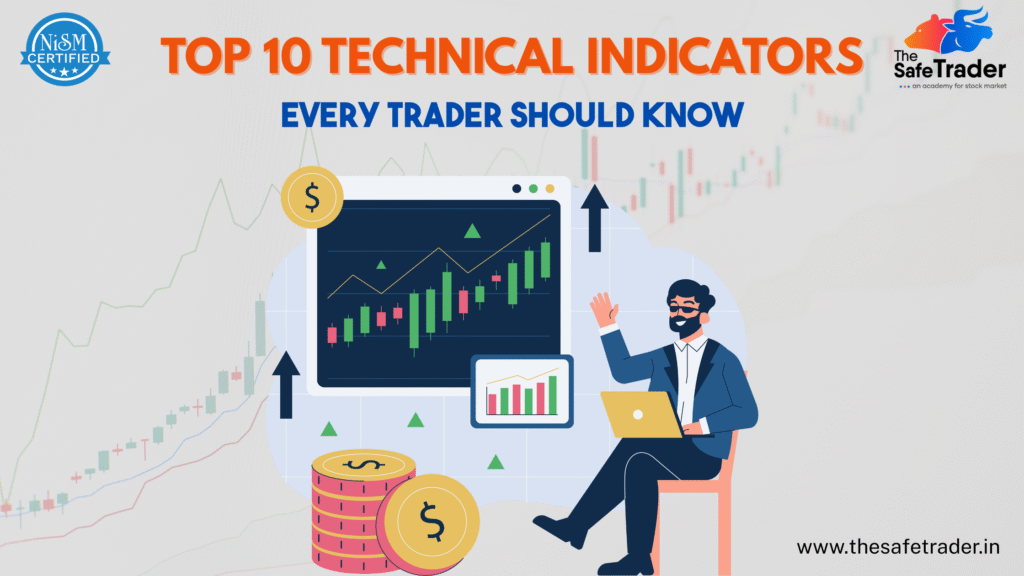Top 10 Technical Indicators Every Trader Should Know

In the world of trading, technical indicators serve as powerful tools to analyze price action, identify trends, and time entries and exits. Whether you’re trading stocks, forex, or cryptocurrencies, indicators provide a structured approach to interpreting market data. The article aims to explain technical indicators, what makes them useful; with advantages and limitations; and also the top 10 indicators every trader should know. What Are Technical Indicators? Technical indicators are mathematical calculations derived from price, volume, or open interest. They are primarily shown as visual overlays or charts that appear alongside the price of a given security. Traders use them to observe trends, reversals, momentum, and time their entry and exit. These indicators are an essential part of technical analysis, which considers historical price and volume data, rather than earnings or news type fundamental data. Why Do Traders Use Indicators? Identifying Trends: To ascertain whether the market is moving upward, downward, or is going sideways. Reversals: When a trend is about to exhaust itself or change direction. Confirming signals: To validate price patterns or breakouts. Entry and exit: Time indicators for entry and exit. Manage risk: Determine the volatility to set stop-loss accordingly. Advantages and Disadvantages of Technical Indicators Advantages Disadvantages 1. Moving Averages (MA) Category: Trend-Following What it does: Moving Averages eliminate the volatile behavior of past prices to offer the trend attitudinal direction over a specified time frame. Types: Simple Moving Average (SMA): Takes all closing prices throughout a given time period and divides by the number of time periods. Example: A 10-day SMA = Sum of last 10 closing prices ÷ 10 Exponential Moving Average (EMA): EMA works the same way as the SMA with one difference: it puts more weight on recent prices, making it more sensitive to price changes. Common Uses: Strengths: Limitations: 2. Relative Strength Index (RSI) Category: Momentum Oscillator What it does: RSI estimates the magnitude of recent price changes to assess whether a stock is overbought or oversold. Formula: RSI = 100 – [100 / (1 + RS)] Where RS = Average gain during the last N periods / Average loss during the last N periods (generally 14) Interpretation: Strengths: Limitations: 3. Moving Average Convergence Divergence (MACD) Category: Trend + Momentum What it does: It measures the difference between two EMAs, usually the 12-period and the 26-period, and has a signal line, which is a 9-EMA of the MACD, so that buy or sell signals can be generated. Components: Key Signals: Strengths: Limitations: 4. Bollinger Bands Category: Volatility What it does: Bollinger Bands comprise a middle band (20-period SMA) and two outer bands, usually set at ±2 standard deviations, signaling the level of market volatility. Interpretation: Strengths: Limitations: 5. Stochastic Oscillator Category: Momentum What it does: Compares a stock’s closing price with its range in the past time period—mostly 14 days. Formula: Interpretation: Strengths: Limitations: 6. Volume Category: Confirmation tools What Is It? Volume measures the shares/contracts that have been traded during the defined time period. Why It Is Important: Related Tools: Strengths: Limitations: 7. Average True Range (ATR) Category: Volatility What it is: The ATR is a measurement of market volatility that calculates the average range of price a security has traded during the past set time period, most commonly 14 days. Formula: True Range = Maximum of: (High – Low) ATR = 14-period moving average of True Range Utilization Cases: Strengths: Disadvantages: 8. Fibonacci Retracement Category: Support/Resistance What it does: The retracement uses key Fibonacci ratios (23.6%, 38.2%, 50%, 61.8%, and 78.6%) to predict possible support or resistance areas. How to Use: Application: Strengths: Limitations: 9. Parabolic SAR (Stop and Reverse) Category: Trend-Following What it does: Plots dots on the price chart to mark potential trend reversals and act as trailing stop-losses. Interpretation: Strategy: Strengths: Limitations: 10. Ichimoku Cloud Category: Multi-functional (Trend, Momentum, Support/Resistance) Function: Gives a comprehensive view of market sentiment and trend direction with five components. Components: Interpretation: Strengths: Limitations: Can You Rely on Indicators to Make Profits? Yes — but with caveats. Indicators do not have the ability to foresee and tell you about the future. Instead, these indicators tell you about the last hour, day, month, or year, the market volumes, highs, lows, collars, open interest, prices, trends, and many more to help you make an informed decision. If you’re a successful trader, you’d never rely on one single indicator. Instead, you apply many indicators, look for confirmation, combine them with price action, risk management, and analysis of market context. Indicators work best when: – Two or more indicators are used in confluence (agree) – Clear rules for risk management are established to accompany them – Back tested and tailored to fit the trader’s framework Yet one must avoid extremes in reliance. For in reality, there is no single indicator that is correct in every condition ever faced by an active market. Hence, trading surely boils down to strategy and discipline and adaptability with the existing conditions and not merely technical signals. Final Thoughts Technical indicators are important market analysis tools but clearly not in the realm of certainty. Knowing how each indicator works, measuring factors, and when to use it is the main pillar of the trade strategy building. Those top 10 indicators should be a solid building block with which further trade strategy building or refining can continue. Pro Tip: Pick 2 or 3 indicators that go well together, test them on historical data, then build your system from there with confidence! Want to Know More Details, Please Click Here
